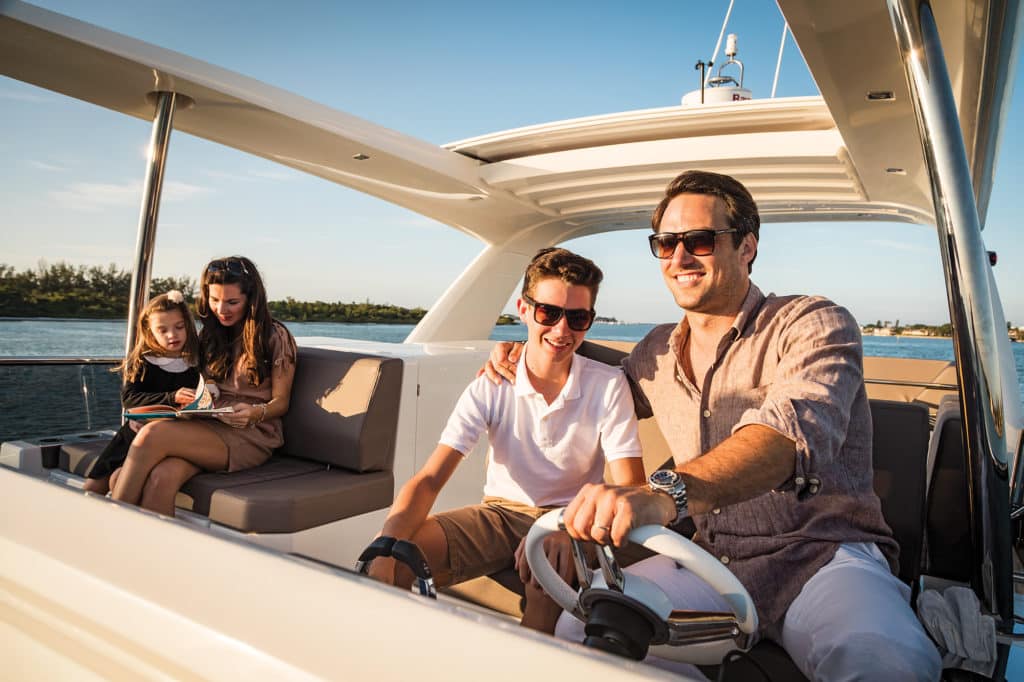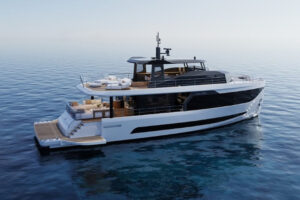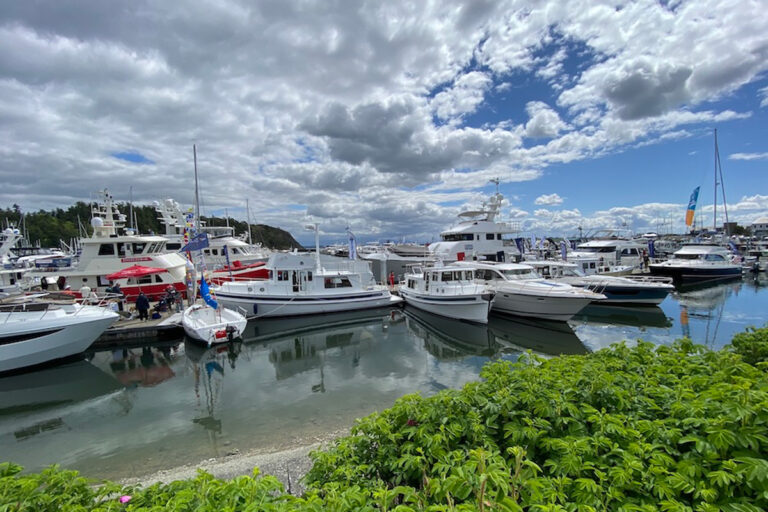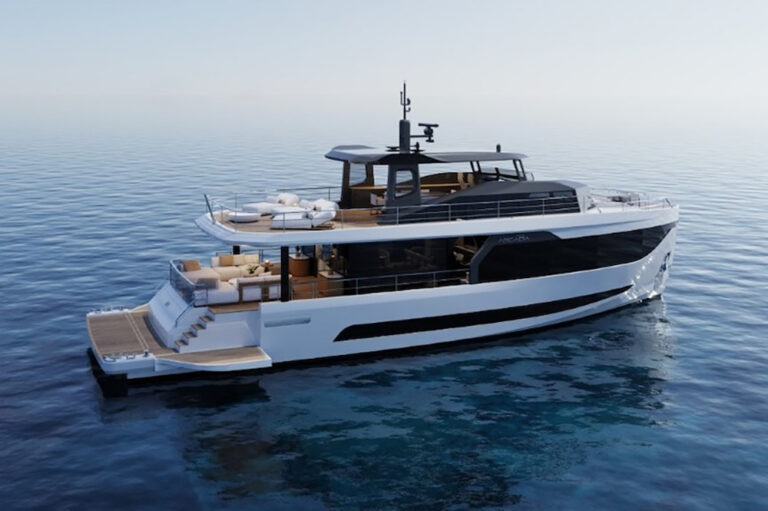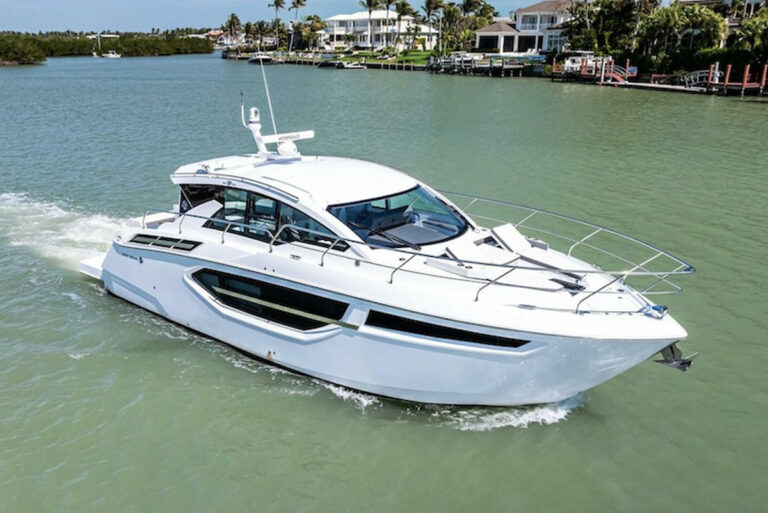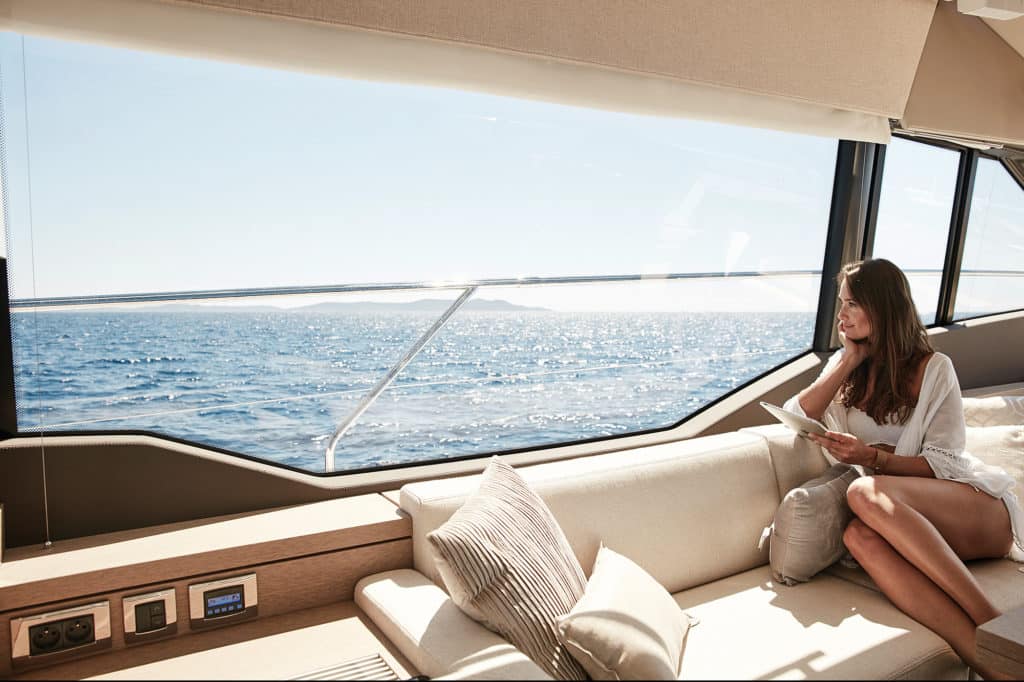
Steps. They are a means of transporting someone, or something, from one level to another. Steps, as they relate to the Prestige 630, transport a yachtsman from a craft that runs through the water to one that feels like it’s floating above it. But these aren’t steps in the traditional sense; they are a build technique that lowered the 630’s center of gravity considerably. That, in turn, created the vessel’s pillow-soft ride.
How did it happen without compromising the build? A lot of math.
To create the interior volume and nearly 7 feet of headroom throughout the yacht without steps, the 630 would have needed its three decks stacked at a height stretching to about 12 feet. That would have made for a tender-riding yacht. To solve this problem, Prestige added steps: areas hidden above the salon headliner where the superstructure drops about 1½ feet per section, all strategically placed. Where each step occurs, build material is overlapped, beefed up and reinforced to help distribute force incurred underway.

An added benefit is the reduction of material required to keep the 630 sturdy and stout while taking out weight. When you remove weight, you require less horsepower to propel the yacht. When you need less horsepower, you need less fuel. When you put those two things together, you get optimized performance and a vessel with longer range, faster speed and improved handling.
There’s one step in the salon. Another is at the galley aft, and another is where the interior meets the cockpit door. This keeps the headroom consistent, eliminating the feeling of ducking down. And when you remove that foot-plus of height out of each step, you’ve reduced overall vessel height by about 5 feet. Hence, the lower center of gravity. The natural low profile of the yacht, plus the optional Seakeeper gyro, makes the 630 a vessel that’s as stable as a table underway.
I know because when I ran our test 630’s fully infused, cored-sandwich hull out of Sarasota, Florida, there was nothing that 20 knots of wind, waves or wakes could do to dissuade the yacht from her appointed duty. She soldiered on, unfazed.


My 630 was powered with twin 725 hp Volvo Penta IPS950s, which shined. The engines pushed my 54,470-pound (dry weight) test yacht across the water at an average top hop of 29.9 knots. The motors burned 70 gph and turned 2,550 rpm, within 50 rpm of their rated maximum of 2,500 rpm. Her fly-by-wire steering was real-time responsive, turning 360 degrees in about two boat lengths. She had a sporty feel for a 63-footer too, helped in part by the moderate setting programmed into the IPS drives. (The builder can set the rate of turn for the pod drives to the best fit for the yacht.)
Dialing the motors back to 2,250 rpm put the vessel into a steady 24-knot cruise with the diesels consuming 52 gph. With a 713-gallon fuel capacity, that translates into a range greater than 340 nautical miles at cruise speed, with a 10 percent reserve.
The sea trial was admirable, made even a bit more impressive when you consider that several straight-shaft-powered peers need up to 1,150 hp to achieve the same performance numbers while burning more fuel. The impact of those steps is evident again.
And I can’t overstate the effect the steps have on the yacht’s interior spaces. The unobstructed salon stretches from the sliding cockpit doors to the helm, all the way forward to starboard. In between the cockpit and salon to port is the galley aft with three-burner Bosch cooktop, Miele microwave/convection oven and dishwasher. The galley serves guests both inside and outside with a flip-up window to the cockpit. Open up the sliding doors, and the 630’s entertainment area stretches about two-thirds the length of the yacht. So don’t be shy with the party invites.

Those guests will have room to lounge in the salon with an L-shaped settee to port, a chair and another settee for three. All are within earshot of the helm, which has a bench-style seat that can flip up to a bolster for stand-up driving. The settees and chair are made of a synthetic PVC material for durability in the saltwater environment, but Prestige can accommodate owners who prefer a different fabric or leather.
There are two interior wood options for the 630: gray oak soles with wenge accents, or wenge soles with gray oak accents. Either way, the feeling you get walking into the yacht is clean and modern.
The same description holds for the master stateroom, accessed to starboard via its own stairway from the salon. Just eight steps down, the room opens up to full beam (16 feet 4 inches). And above the head of the berth is the step from the salon to galley level on the main deck. As in the salon, the headroom here can accommodate your NBA-playing friends. A hanging locker can handle the most challenging clotheshorse for your week or longer sojourn. The master has an en suite head plus a settee to port for rainy days on the hook with a good book, and a vanity to starboard when prepping for a nice dinner ashore at your favorite port of call.

Rounding out the accommodations is a forepeak VIP stateroom with step-up berth and vanity, and a third stateroom abaft to starboard. Both of these guest staterooms are en suite. The third stateroom has twin berths that can slide together to make a double. Interestingly, when the berths are combined, the end table between them disappears, but a new one that is under the inside berth appears.
A crew cabin is accessed via the yacht’s swim platform. Most American buyers will likely be owner-operators, instead using this space for gear or toy stowage.
The Prestige 630 has a story much deeper than her 3-foot-3-inch draft. She is a tale of a builder constantly striving to improve: to maximize every extra inch of available space and then some, to optimize every ounce of speed, and to wrap all that functionality and performance in a vessel that exudes substance, style and comfort.
It’s a lot of math, and the numbers add up to excellence for this voyager.
